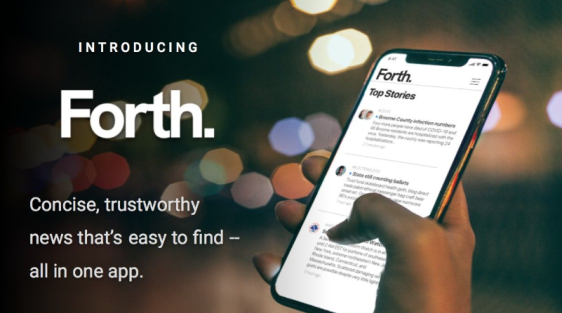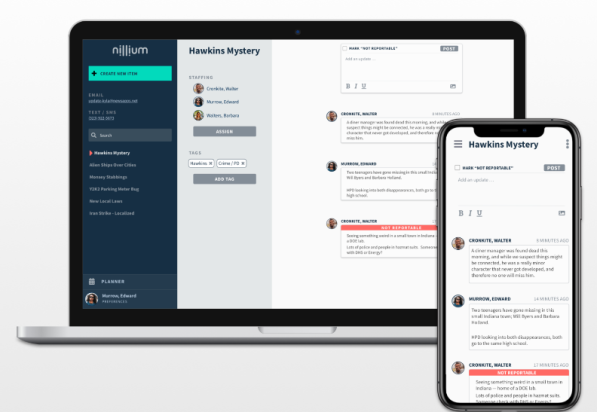
Startup To Serve Local News To Young Audiences
June 3, 2021
After spending several years as the head of news at Snapchat, Xana O’Neill paused to ponder the problems the entire news industry is facing. She kept coming back to the notion that there is no platform 18- to 34-year-olds could turn to to get trusted information.
So she decided to make one.
Enter Forth, a news product that is geared toward the 18- to 34-year-old age group and has the look and feel of social media. The product unveiled its soft launch late last month.

There’s no doubt that publications have been perplexed about how to acquire the next generation of news consumers. Over the years that age group has gone from MySpace to Facebook to Snapchat to TikTok to Twitch to ... well, platforms we don’t even know about yet. And all the while, news publishers have failed to find a cohesive strategy to meet those users where they live online.
On one hand, people put little trust in the news that appears on their social media feeds. But on the other hand, the younger generation is more likely to get its news this way because it doesn’t engage with newspapers, TV stations or even websites. This age group’s brand loyalty lies with the social platforms or individual creators, not publications or TV networks.
O’Neill has some insight into what makes this age group tick from her time at Snapchat. She also knows the news industry, having worked at ABC News, NBC Local, New York Public Radio and the New York Daily News. And she has ideas on how to get quality journalism in front of this mostly untapped audience and have them actually consume it.
So what makes Forth different? Well, there’s a lot to go through, both on the audience side and on the publishing side.
Let’s start with what the audience gets.
The content on Forth will be concise, but will provide context, O’Neill said. It won’t, however, rely on the clickbait that publishers on social media have resorted to for so many years.
“We wanted to see how we could change the incentive structure to not reward clickbait and to surface important local stories,” O’Neill said.
Here’s an example of the type of content that will appear on Forth: a Q&A with some of the candidates for the local council race. The content, which can be text, photos, videos and more, feels like social media, especially a Twitter thread, but it is actual journalism, created by real journalists. It’s just designed to be consumed in a social media environment.

At launch, Forth will focus on New York City’s Upper East Side. That’s the home base of O’Neill and her team, so it made sense for them to start close to home. Plus, there are PLENTY of folks in the age group they’re targeting there.
Forth will include both local and national content.
O’Neill said the plan is to prove the concept works there and then expand into other areas of the country that include a high number of 18- to 34-year-olds — places like Austin and Boston, for example.
The Forth app works by geolocating you. You’ll get content for free in that location.
“If you want to follow what’s happening in your hometown, or in California (for instance), then you can pay a subscription fee to see what’s happening in another market.”
So where will the content come from?
The editorial team at Forth will acquire it in several ways. One is by tapping into the growing creator gig economy. The Forth staff will post assignments (and the amount they’re paying) to a stable of previously vetted journalists who agree to adhere to Forth’s standards and editorial policy. The journalists can then claim the assignments, do the reporting and post their work to the platform.
The other way is by working with existing local newsrooms across the country. Forth has developed a Reporting Management System, which it describes as an “internal newswire.” Basically, reporters and editors can organize their news gathering internally on each story in the RMS — both reportable and non-reportable — through the web, via email, Slack or even a text message. The reportable information can be posted to the Forth app and to social media, and can be embedded into a website in a live blog format. The RMS also can integrate with Slack, email and Google docs.

The Forth team can provide the RMS to newsrooms for free. That means those newsrooms can then syndicate updates to Forth and get a rev share in return.
As far as journalism business models go, Forth is an interesting one. It focuses on an untapped audience. And it tries to provide content in a format that makes sense to that age group. And at the same time, it blends traditional journalists with the emerging creator economy.
“There are reporters who have been laid off in last year and still want to cover stories, and there are so many stories at the local level that are begging to be told,” O’Neill said. “But the platforms aren’t built with news in mind.”
Will Forth finally be the local news platform that resonates with a younger audience? That’s yet to be seen, but it’s definitely worth a shot.
For more information about Forth, email O'Neill and her team at [email protected].
